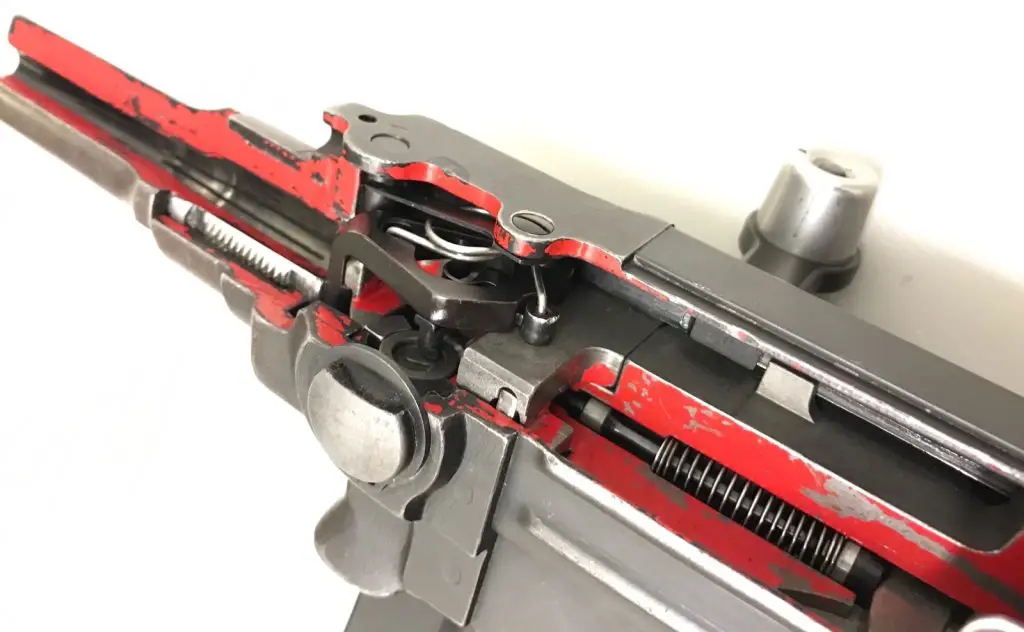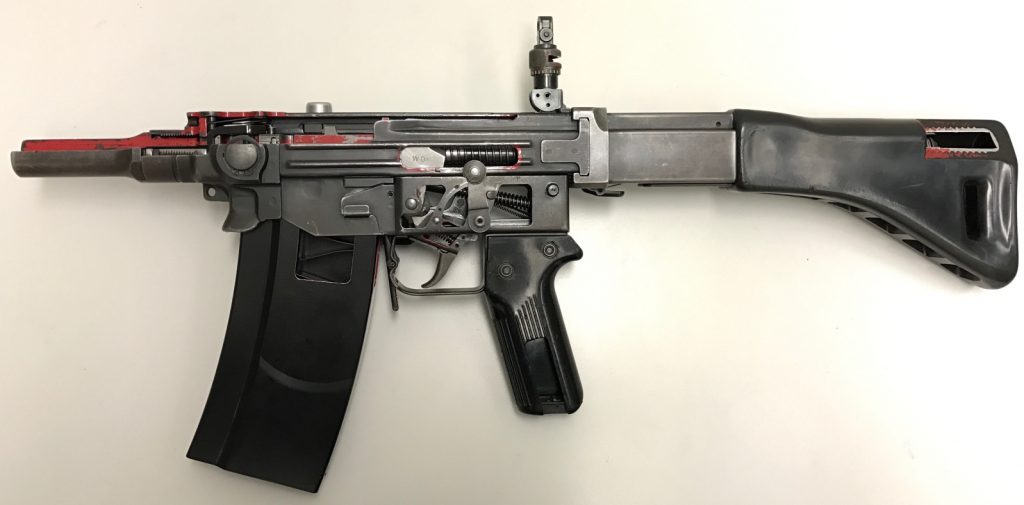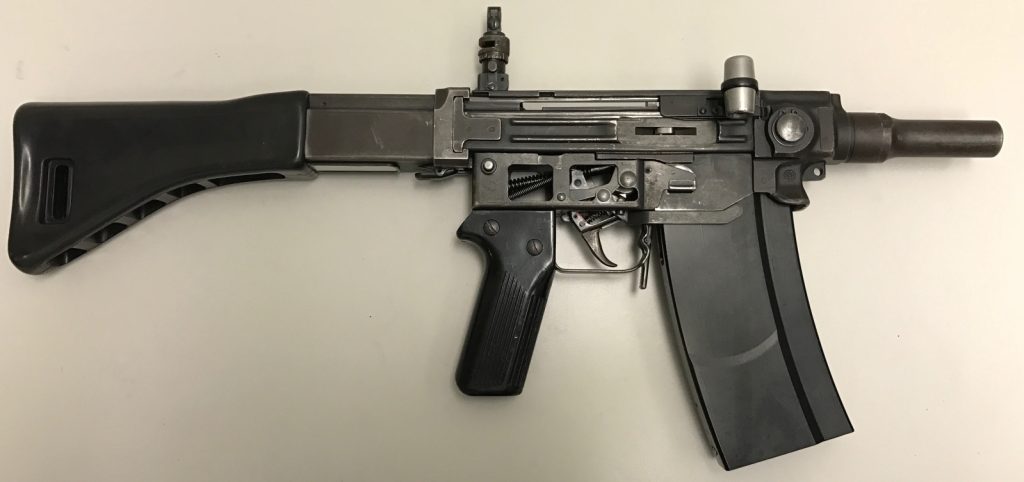Thanks to Chuck at GunLab for turning us on to this incredible post on the Swiss Rifles message board. As Chuck tells it, Dale got hold of, not a rare StG 57, but a rare2 cutaway version of the StG 57.
And then he posted a series of photos and a thoughtful analysis of this highly unusual rifle that replaced the Swiss Army’s rifles, light machine guns, and submachine guns at once. (Does that make it the Swiss Army Knife of rifles? Sorry, couldn’t resist.)
As Dale explains, there’s a lot that’s unique about the StG 57:
The Stgw 57 is an interesting battle rifle. The rationale behind this gun was to arm the infantry with an “universal weapon” that would replace the bolt-action rifle, machine gun and machine pistol. It was selected in late December 1956 over the Waffenfabrik Bern competitor for cost reasons (the SIG prototype costed only 495 CHF to produce over the 1100 CHF that the W+F Bern model required).
It was always expensive, and while a semi model sold in trickles in the USA, the high price and the rare (here) 7.5 mm caliber kept it from taking off. One of our team sergeants had one and it was a thing of rare beauty (we think he later traded it for an NFA registered 4.2″ mortar). A later export model was chambered for 7.62 mm NATO, but it didn’t sell any better.
It incorporates a modified roller-delayed blowback mechanism inspired by the StG45/Gerät 06 H prototypes, folding sights from the FG42, and a buttstock socket just like the famous MG42. In order to reduce production costs, SIG used innovative production techniques and rubber/polymer materials for the rifle’s construction, in an effort to minimise the number of machined parts.
The cutaway provides a rare chance to truly observe and understand this unusual weapon. The original post includes comprehensive photographs and explanations.
Of course, being a Swiss rifle, no compromises were made on the quality of the construction and overall robustness. Because of its heavy, welded, machined, stamped and brazed construction, the Stgw 57 weighs a whopping 6,5 kg fully loaded! Not only is the rifle one of the heaviest service weapon of the world, it is also one of the most expensive! Each Stgw 57 costs the Swiss government a grand total of 1000 CHF (of which 495 CHF are production costs and 75 CHF accessories).
In this post, we’ve placed a couple of selected images. But really, you must go there and Read The Whole Thing™; you’ll see many more images and each one has a deep technical description of what you’re seeing. Very highly recommended!

Kevin was a former Special Forces weapons man (MOS 18B, before the 18 series, 11B with Skill Qualification Indicator of S). His focus was on weapons: their history, effects and employment. He started WeaponsMan.com in 2011 and operated it until he passed away in 2017. His work is being preserved here at the request of his family.





16 thoughts on “Assault Rifle, Alpine Style, Clear as Ice Edition”
Didn’t Colonel Cooper like the semi-automatic only variant the 510-4 – AMT (American Match Target)?
I suspect, Colonel or no, he never had to carry something this weight for any distance in combat movement. The problem with replacing rifle, SMG and LMG all in one go (as the US tried to do with the M14 and M16) is that you compromise one or more of those combat tools. The Swiss were biased towards an LMG, hence the weight of the beast (something like 6-7 kG!), but they didn’t have a rapid reload like the Bren’s top-mounted mag. (ISTR that the British Army at first intended a heavy barrel FN to replace the Bren, but they thought better of it). The US was biased towards retaining the M1, and did that, essentially, with the M14; it was a no-go as SMG or Carbine replacement, and attempts to make an LMG or BAR replacement out of it were pathetic. The M16 covered the rifle and SMG okay, but we still needed an LMG, which the Belgians kindly developed for us after our program wallowed for years.
I think classifying the StG 57 as an “assault rifle” is more than a bit inaccurate. The Swiss did not intend to play “tank troopers”, and have their infantry running around the battlefield doing close-quarters fights. That full-auto feature on the StG 57 was not meant to be used like the AK-47, where it substituted for things like the Ppsh-41-It was meant to fill the role envisioned for the FG42, an LMG that could also serve as an individual weapon. As such, the term “assault rifle” isn’t accurate, because they never meant for the things to be used in the assault on full-auto, except in really extraordinary circumstances. If you go looking at the Swiss small tactics manuals, there’s really not a lot of focus on things like clearing buildings with them, or things of that nature-These weapons were meant to be used up in the mountains, conducting automatic fire from lengthy stand-offs, vice the assault rifle role of close-in combat during the attack.
I don’t like the term “battle rifle”, because it’s a contrived creation of idiots that really have not a fucking clue about tactics or how these weapons are used, as well as being a non-sequitur, but for lack of a real descriptive term that fits this thing, I think I’d prefer to use that term to describe it. Whatever the StG 57 is, it sure as hell isn’t an “assault rifle”, even though that’s what the Swiss called the damn thing.
Or, we’re using a different sense of the word “assault”, which to me means the close-in battle on the objective. The Swiss may have meant it more in terms of a “long-range mugging”, which is how they meant to use these things on full-auto.
I didn’t name it “assault rifle.” The Swiss Army called it Sturmgewehr.
And here is Ian of Forgotten Weapons discussing the rifle in a recent YouTube video…
https://www.youtube.com/watch?v=Y73Zcg9icJc
The StG 57 is a perfect exemplar of what I’ve always advocated in small arms design: First, determine your tactics and operational intent, and then design your weapon around those.
The Swiss did not intend to fight like the mechanized hordes they expected to face. So, they determined to maximize their stand-off potential, and avoid close contact with the enemy. As such, the StG 57 has all the features it does to support that tactical and operational intent.
Would that our own small arms establishment integrated things as well, and did as much thinking about designing to support the tactics we use. Frankly, the StG 57 or equivalent is probably what we should have been issuing a lot of our guys in Afghanistan…
Of course that’s what the guys needed in Afghanastan. Because nothing says “light infantry” like a 12 pound rifle with optic / PEQ / taclight on top of body armor, helmet, 3 days of food and water, NODs, radios, batteries, extra M240B / M249 ammo or 60mm mortars, extra socks / boots / t-shirts / uniform, e-tool, IFAK, SKEDCO, LAW / Carl Gustav / AT-4, reflective PT belt (shut up and do as you’re told), and whatever else CSM comes up with. Hooah.
And, here we have the perfect illustration for what is wrong with our small arms community, as well as a lot of our infantry units.
The point that you don’t need to be hauling around as much of that stuff, ammunition included, if your weapons are actually effective and, more importantly, lethal out to long range, escapes most of us. We’d rather lug along two-three M240s and a shit load of ammo for them, than take one M240, a decent tripod, and a lot less ammo. The fact that the tripod is going to enable precision fires to be delivered right where they’re actually needed, as opposed to spraying the side of the hill with a shit-ton of ammo off a bipod…? Black magic, that is.
Which goes a long, long way towards explaining why the US still has the primitive-ass M122 derivatives on issue, and don’t even want to consider something like the “too heavy” Lafette mounts, ‘cos, donchaknow, all that “extra weight” could be ammo, or something…
Pro tip? If you can actually deliver accurate fire that kills the enemy out to 1600 or so meters, you probably won’t need all that ammo. But, again, that’s like rocket science, and scary. Training your gunners to be able to do that within 30 seconds would actually require spending some time on the ranges with them, and having to build realistic ranges, where you could learn how to do that sort of thing effectively…
As well, I note that you miss the point where I suggested that we needed something like the StG 57 in “a lot of” the troops hands. That ain’t quite “everybody”, but that fine point is one a lot of people miss.
Examining how the Swiss intended to fight in the Alpine areas of Switzerland might have been something we should have looked at, going into Afghanistan. They might know a little something-something about such affairs, having trained for it for years.
The point that the Swiss transitioned to the StG 90 only after they changed their defense plans and tactics is something a lot of us miss, in that they went from the idea of defending the “Alpine redoubt” to “Defend the lowland border areas”, which necessitated a somewhat different weapon and cartridge. If the Germans or Soviets had come into Swiss territory back during the WWII-Cold War era, the intent was to fall back into the mountains, and bleed the bastards dry when they tried coming after them. The Swiss knew they couldn’t defend the lowlands, so they intended to abandon those to the enemy, and pull a Russian “Let’s lure them into the mountains, where we have all the advantages, and they’ll freeze to death…” strategy. Probably wouldn’t have worked out, over the long haul, but I wager that the Germans and Soviets both would have known they’d been in a hell of a fight, after it was all over.
Part of the reason our guys are so damn overloaded in Afghanistan is that we’re taking a set of small arms into an infantry fight up in the mountains which were optimized for taking part in mechanized warfare in Northern Europe, which would have meant that most, if not all, engagements we needed to win and dominate were within 300m, virtual knife-fighting distance. So, when you take those into the hills, which are bare and exposed, and suddenly need to engage those assholes with PKMs up on the ridgelines, you wind up having to carry a shitload of extra ammo, because, well… You’re having to substitute mass fire for precision. Put a couple of StG 57 equivalents into the squad, and suddenly, you’ve got a couple of LMG-analogs that can deliver precision fires onto those guys, and, gee, that means that we’re having to carry a lot less ammo… From a systems standpoint, the StG 57 might actually wind up being a lighter solution, although the individuals carrying the sumbitch might not think so.
As well, the Swiss were not into what we’re doing in Afghanistan. They intended to be playing the Taliban role, to whomever was foolish enough to invade. Countering that? The Germans intended to use a lot of artillery, while the Soviets would probably just have backed off and made generous use of tactical nukes.
If you have artillery/air superiority don’t you just need the radio?
Kirk
When the enemy has “ROE superiority” over you, the radio and all the support it can call for is useless.
The fundamental mis-match between “how we’re gonna fight” and the weapons we’ve put on issue is the problem here-We’re taking a small arms suite into mountain combat while eschewing the majority of the supporting arms it was designed around being available to the guys doing the fighting, and we’re wondering why it is we’re losing the number of engagements we are.
A squad whose weapons are designed around deliberately engaging in small arms-restrictive fights will look a lot different than the ones we’re fielding, which are (somewhat…) intentionally designed from the cartridge up to integrate with a bunch of supporting arms like artillery, aviation, mortars, and the like. When you get down to it, the suite of weapons we have in our infantrymen’s hands these days is pretty much just a set of tools optimized for close-in fighting and providing local security to the heavier weapons and FCO/FAC teams. We have not designed our weapons or tactics to be effective in small-arms only fights; that’s why the range and precision mis-match has crept up on us. Not to mention, little supporting things like the tripods and so forth…
Shit… Fat-fingered “FSO” to “FCO”, there…
Am I the only one who gets aroused by the sight of that lovely rifle?
No. No, you are not…
The StG 57 is one of those rifles you look at, initially go “Meh… What the hell were they thinking…?”, and dismiss as some foreign ass-hattery. Then, you get a detailed introduction to one, from someone who knows the real deal about it, and suddenly… The beauty of it all snaps into clear focus, and you’re in love.
If I were to ever win the Lotto, one of the first things I’d be doing with the recreational portion I’d allot myself would be to buy as many of those things as I could afford, and set up a nice, long range somewhere in the mountains, and do some serious shooting with them. I don’t know if they ever brought in the select-fire versions, but I’d damn sure be looking for one…
I too have always loved these guns. I think though,I would go with the AMT. Being 9lbs and in 7.62nato it might be a little easier to hump around in the mountains. The only downside is that the sights are not the same awesome sights that the STG 57 has,more like a FAL.
SIG production of the Stgw.57 lagged far behind its contractual delivery schedule into the late 1970’s. The Swiss government was furious at the development of the AMT variant and the Chilean export order. Failure to perform fines almost broke Firma SIG in the mid 1960’s. Into the mid 1970’s, the Swiss Army was issuing P.210’s and K.31’s to a lot of soldiers who should have been armed with Stgw.57’s. The Swiss Army also made it extremely difficult for soldiers to privatize their Stgw.57’s when they mustered out. Swiss reservists were forced to turn in their Stgw.57’s and received a G.11 or K.31 in lieu.
Always thought the Stgw.57 should have been called a ‘Fortress Rifle’ – Festungsgewehr.. This nomenclature was always a good way to rile up my Swiss counterparts back in the day. They also got apoplectic when I pointed out that a good MG.42 was far less expensive to produce than the Stgw.57 – and better suited to their strategy.
Interesting. I did not know that about the production issues. Unfortunately, the Swiss military and weapons in general are pretty much a black box to us here in the US-You can only see the outlines of it all, because the majority of the time, it just ain’t getting coverage. Anywhere.
I kinda like that “Festungsgewehr” designation, but I can see why the Swiss objected to it-The fortresses were where the old reservists were supposed to be ensconced, and the young guys were supposed to be out on the rock and ice, doing their thing. I’m not sure what the correct German or Swiss German construction might be for “long-range ambush rifle”, but that might be a less offensive way to term it.
I really think calling these things “assault rifles” is a serious misnomer. I can’t see playing tank-rider, and leaping off of a Pz-61 to go winkle out some Soviet motorized riflemen from amongst the rubble of a Swiss village or town with one of these, and I’ll wager money that if the Swiss infantryman ever had to do that for real, he’d have been sporting a captured AK-series weapon to do it with.
However, in his natural intended habitat, hidden up in the mountains as the schmuck-bait Soviet infantry bobbled along the roads…? Oh, yeah: Gimme that StG 57 goodness.